Now you will create a business dashboard. You will add views to the dashboard and configure them.
- Open the WebSphere® Integration Developer dashboard manager.
- In WebSphere Integration Developer, select Window > Web Browser. Select Default system Web browser or another listed browser other than the internal browser.
- In the Servers view, right-click WebSphere Business Monitor Server v6.1 on WebSphere Process Server and select WebSphere Business Monitor Dashboard.
- When prompted, enter admin for the user ID and admin for the password. You must log in with admin so that you can view the alerts that were set up in Action Services to be viewed by this particular user ID. Also, in the WebSphere Business Monitor toolkit, this is the user that is automatically defined on the secured server.
- Select the Dashboards tab and then the Manage tab.
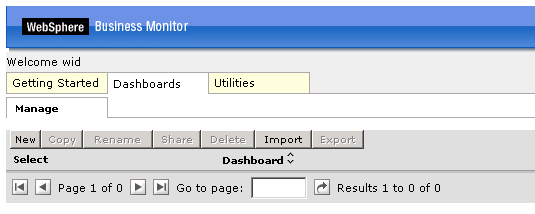
- Click New and then enter a name for the
new dashboard, for example MyDashboard. Click OK. Note: The contents in the views in the dashboards will depend on the actual data that was entered into the forms for the orders.

- Add the instances view to the business dashboard so that you can
view the process instances:
- Click Add to Dashboard, select Instances, and then click OK. You can also add a view by dragging the view from the palette onto the dashboard.
- In the Instances view, click Personalize.
- Click the Advanced tab and select model clipsbpm
(All Versions).

- Click the Show/Hide tab and then click >> to
copy all of the metrics from the available list to the selected list.
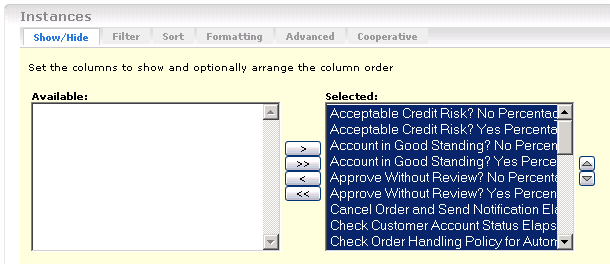
- Click OK. You will see a list of monitoring
context instances for the orders entered.

- Add the Human Tasks view so that you can monitor human activity
in the process instances.
- Click Add to Dashboard and then select Human Tasks. Click OK. Note that you can also add a view by dragging the view from the palette onto the dashboard.
- In the newly added Human Tasks view, click Personalize.
- Select the Show/Hide tab and then click >> to
copy all of the metrics from the available list to the selected list.
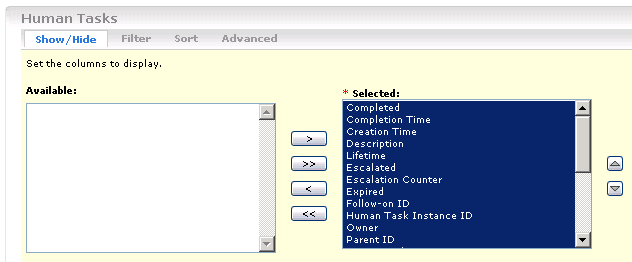
- Click OK. The Human Tasks view is shown
in the following figure.

- Add the dimensions view and configure it to show human task information
in aggregate form:
- Click Add to Dashboard, select Dimensions, and then click OK.
- Click Personalize.
- In the personalization screen, select the following values:
- Monitoring Model: Global HT MM (All Versions) .Note: This is the global human task monitor model that is automatically installed when you install the toolkit.
- Monitoring Context: Global Human Task.
- Monitoring Model: Global HT MM (All Versions) .
- From the Available Dimensions list, select Task
Name Dimension and click the right direction arrow (
 ) next to the Row Dimensions
selected list.
) next to the Row Dimensions
selected list. - Select Task Owner Dimension and click
the right directional arrow (
 ) next to the Column Dimensions selected list.
) next to the Column Dimensions selected list. - Select Measures and click the right direction
arrow (
 ) next to the Page Dimensions text box.
) next to the Page Dimensions text box. 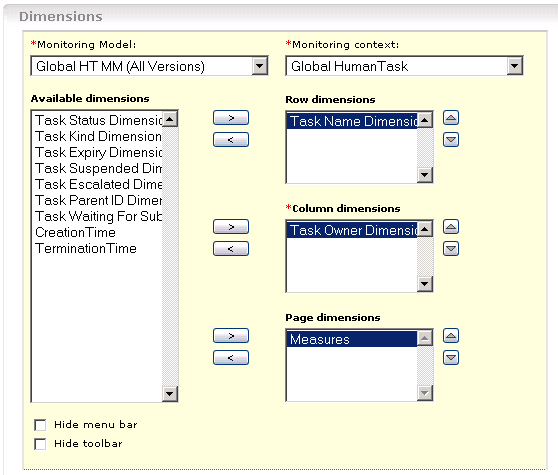
- Click OK. The Dimensions view displays
the instances count by task name and task owner.
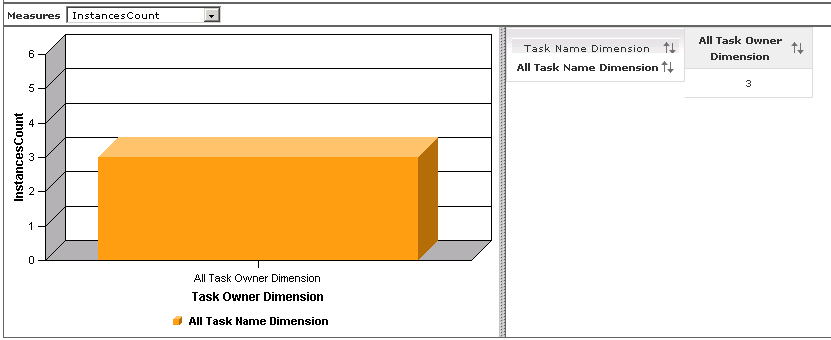
- Optional. You can double-click All Task Name Dimension and All
Task Owner Dimension and drill down to more detailed data. This
is performed in the vast majority of cases.
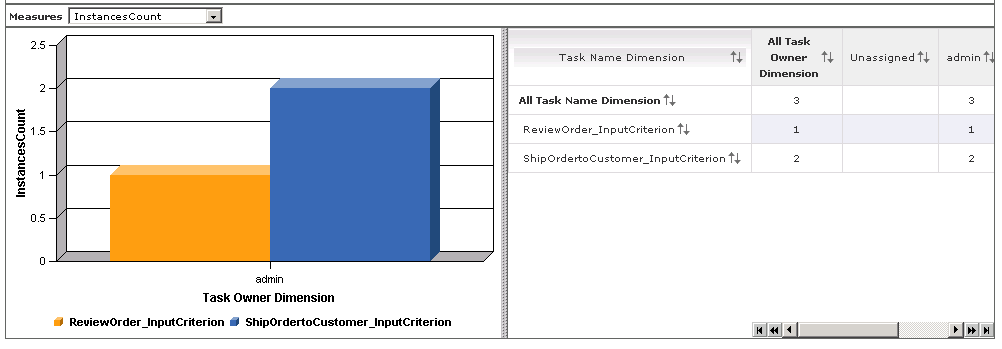
- Add the Alerts view. There are two situation events (outbound events) defined in the model that will generate alerts based on the configuration set in Action Services: one situation event for shipped percentage and one for order processing time. The latter is based on a processing time being greater than 3 days, so it will be difficult to test now. However, you can test the former alert by ensuring that the percentage of shipped orders is less than 85 percent of the total orders. To test the Shipped Orders < 85% alert, click Add to Dashboard, select Alerts, and then click OK.
- Add the KPI view to the business dashboard to monitor the KPIs
defined in the monitor model.
- Click Add to Dashboard, select KPIs, and then click OK. You can also add a view by dragging the view from the palette to the dashboard.
- Click Personalize.
- Expand clipsbpm, and select the KPIs you want to view. You can select all of them if you wish. Click OK.
- Next you will export the monitored values to WebSphere Business
Modeler to improve simulation results and assumptions made in the process
model such as path percentages. Only completed process instances are exported,
therefore, ensure that you have completed some process instances before you
export the values.
- Select the Utilities tab.
- Select the Export Values tab.
- Select the clipsbpm model and then click Export. The data exported as XML opens in a browser window.
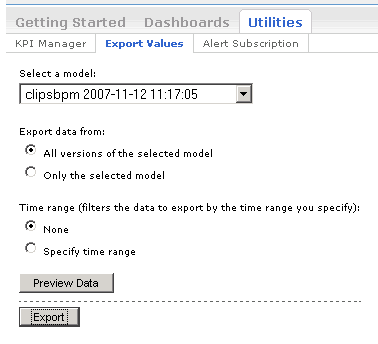
- Click File > Save page as or File > Save as (depending on your browser) and then select your destination folder and click Save. By default, the file is stored as exportvalues.xml. If your browser window does not have a File menu, then copy and paste the content into a file.
- Open WebSphere Business Modeler with the workspace that contains your process model.
- In the project tree, navigate to ClipsAndTacksF1 > Processes > Order Handling (Future 1).
- Right-click Order Handling (Future 1) and select Import.
- Select Monitoring result (.xml) and then click Next.
- Browse to the folder that contains the exportvalues.xml file and select the file. Click Next and then click Finish.
- In the project tree, double-click the process to open the process
diagram. Examine the process diagram to see the updated decision percentages
for the six simple decisions.
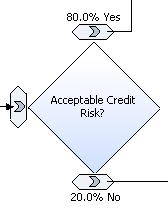
- Examine the updated process duration time by clicking the background
of the process diagram. Click the Attributes tab and
then the Duration tab.

- Examine the updated task duration times by clicking one of the
tasks in the process diagram. Click the Attributes tab
and then the Duration tab. Next click the icon for 'Processing
time'.

- Add a dynamic KPI to the dashboard.
- In the business dashboard, click Utilities and then KPI Manager tab.
- In the Model field, select clipsbpm.
In the Version field, select Latest.
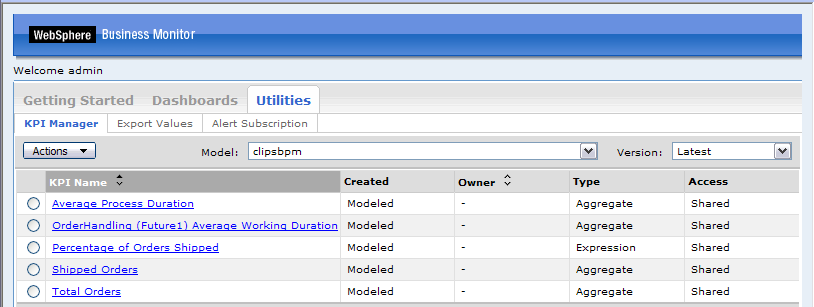
- Click Actions and select New Expression KPI.
- For the name of the KPI, enter Declined Orders.
- For the model associated with the KPI, select clipsbpm.
- For Access, select Shared so that other
users can see the new KPI.
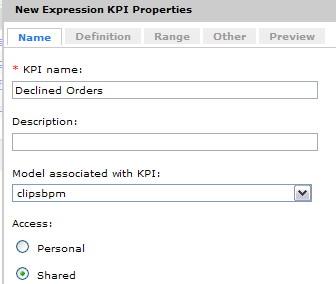
- Create the expression for the new Declined Orders KPI.
- Select the Definition tab.
- Use the KPI drop down list to select Total Orders and click Insert.
- Use the Operator drop down list to select – (minus) and click Insert.
- Use the KPI drop down list again to select Shipped
Orders and click Insert.
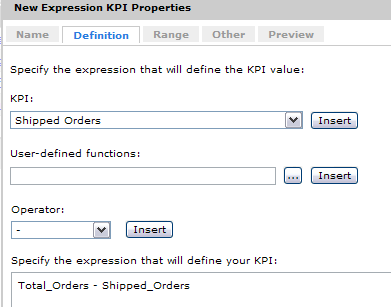
- Click Apply.
- Select the Range tab.
- For Range definition, select Numerical.
- Add two rows as shown below by clicking Add row and
entering the following values and selecting the following colors. Click OK.

- Select the Dashboards tab.
- On the KPI View, click Personalize, expand
clipsbpm and select Declined Orders (the newly created
KPI). Click OK. The new KPI view includes the dynamic
KPI that just built.
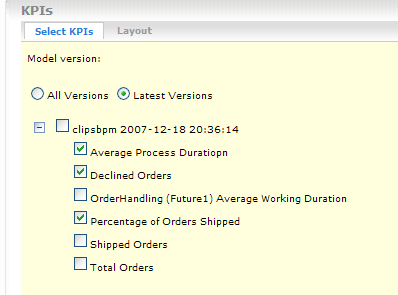
The new KPI view includes the dynamic KPI that just built.
